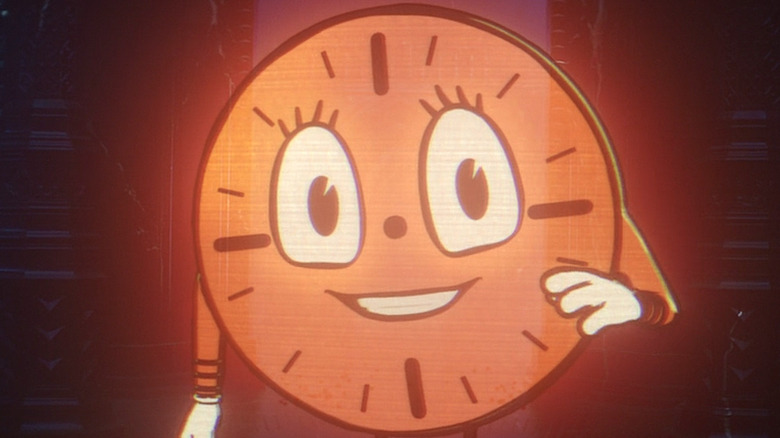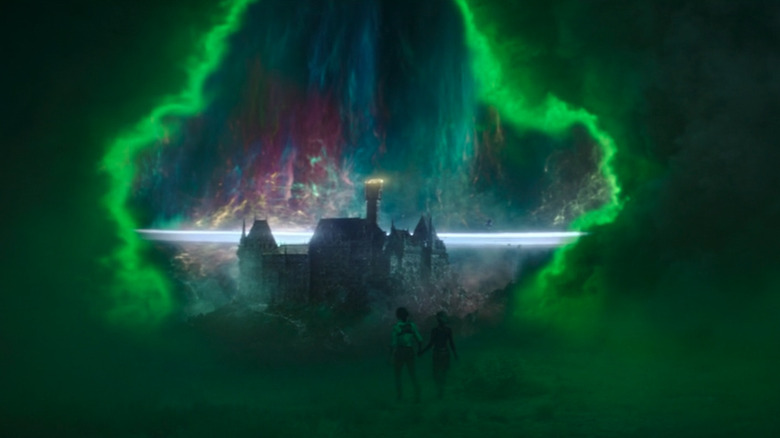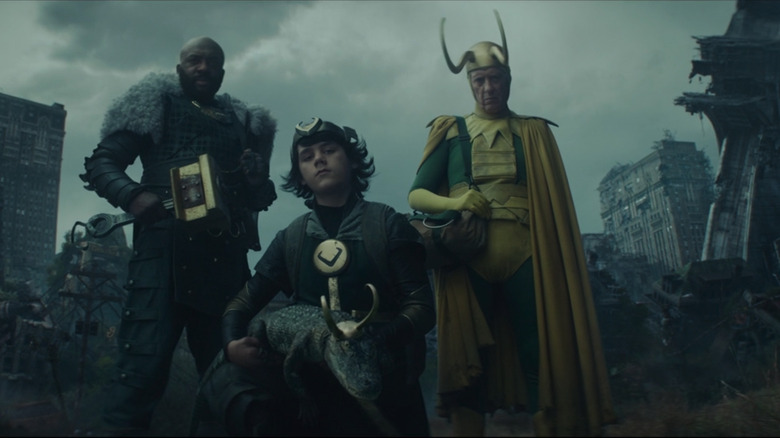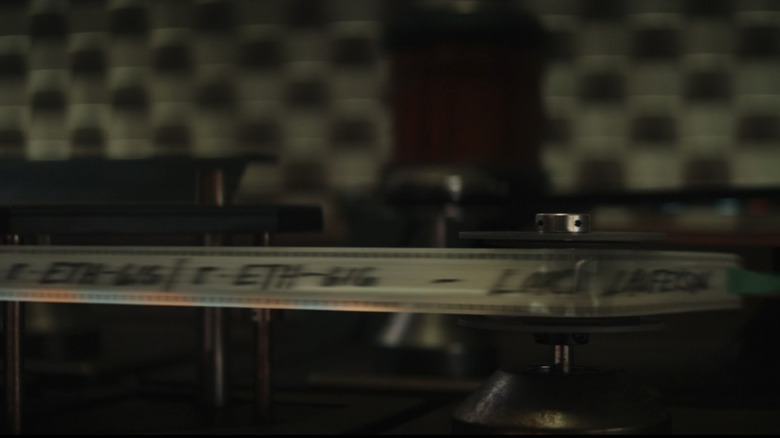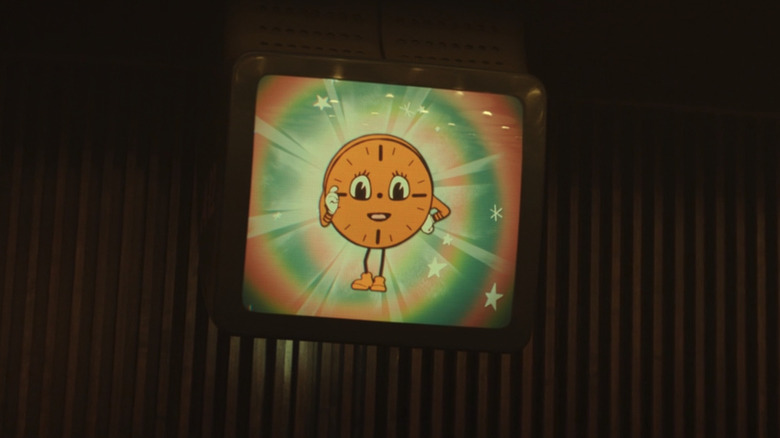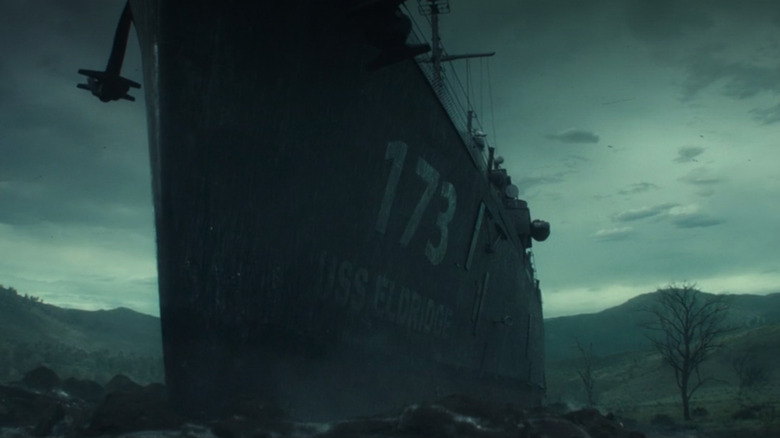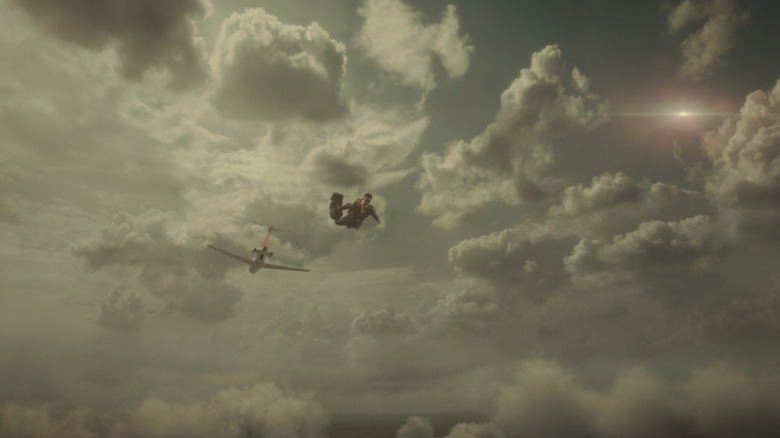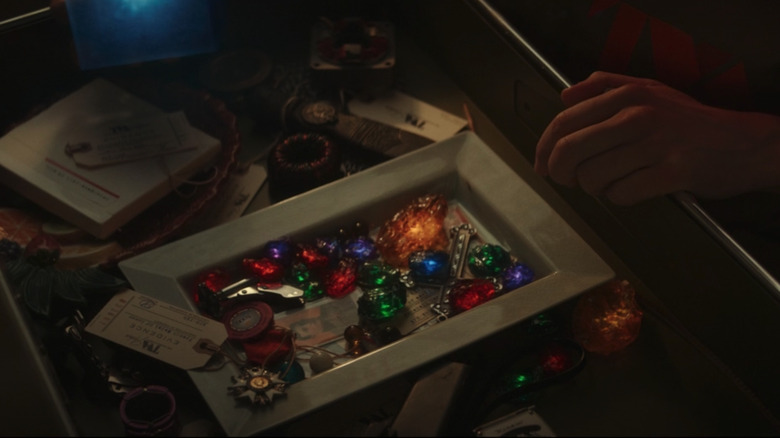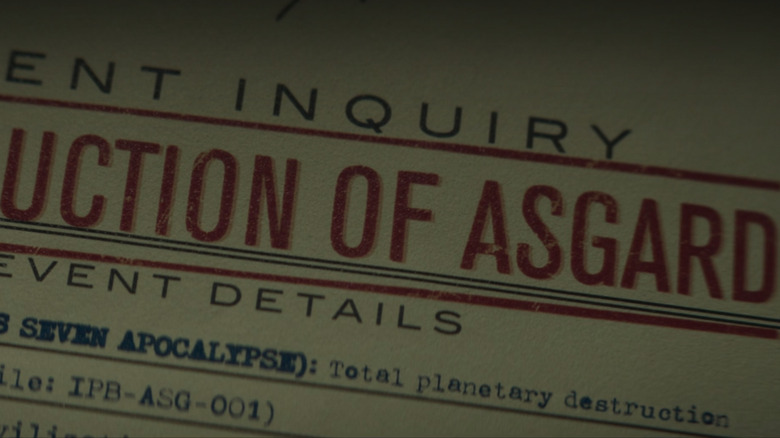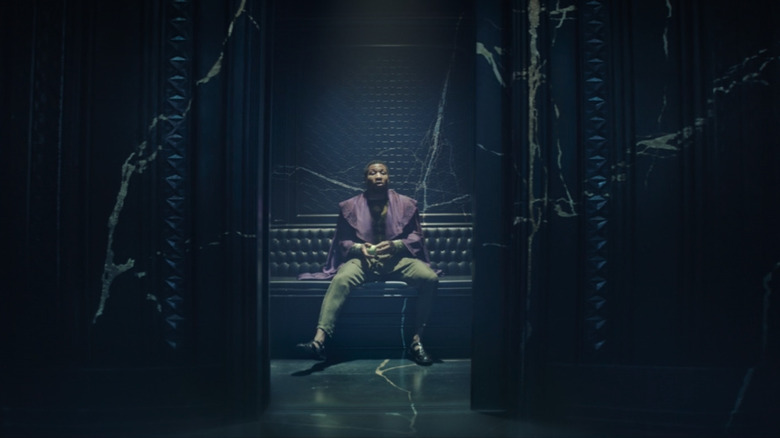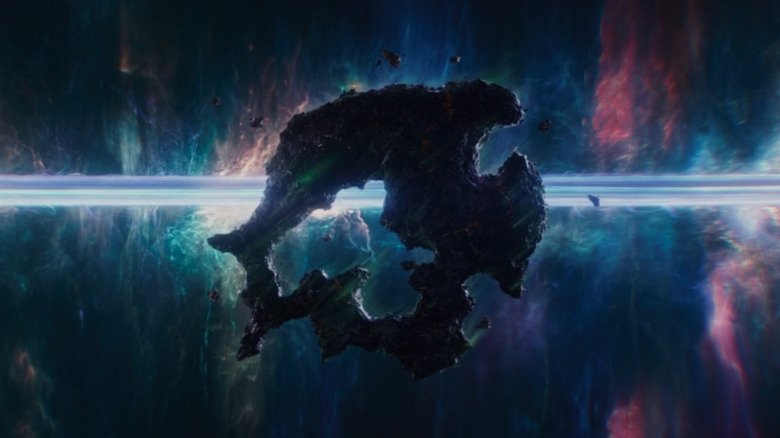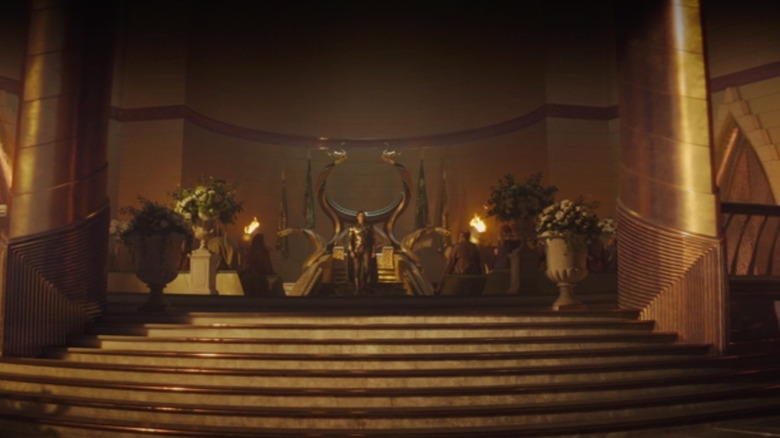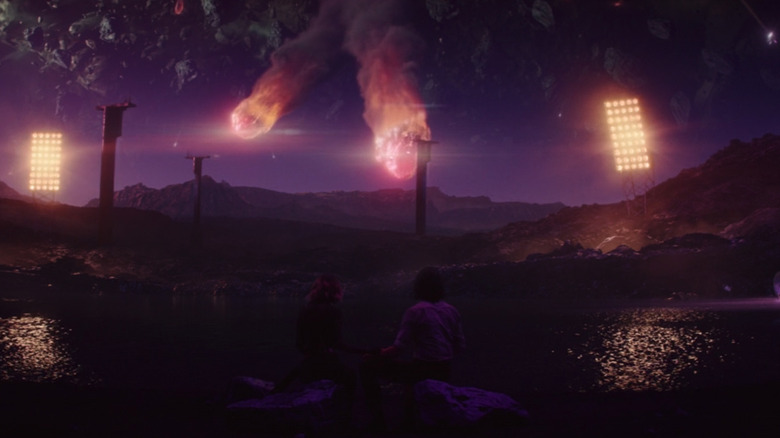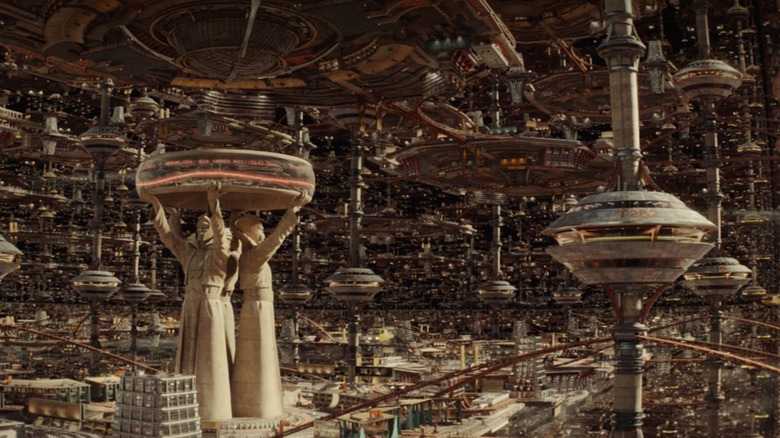The Most Paused Moments From Loki Season 1
When "Loki" debuted on Disney+, few people knew just how transformative the Would-Be King's series would be for his story — let alone the MCU as a whole. By the time the Season 1 finale of "Loki" ended, everyone picked their jaws up off the floor, Googled "who is Kang," and started making plans to watch "Loki" Season 2.
Loki's trip through the sacred timeline was a fun ride, and not just because it introduced the next Thanos-level villain. There were plenty of moments throughout the show that were worthy of attention. Sometimes these consisted of lines that had to be played over and over again. At other times, a still screen was required to catch a quick little Easter egg or some other secret factoid tossed into the background.
We've gone through and gathered up what we consider to be the most paused moments of the series. From beginning to end, these are the scenes and stills that were most burdened with glorious purpose. So without further ado, here is Looper's official rundown — in no particular order — of the most paused moments from "Loki" season 1.
Alioth's defeat reveals... a castle?
The fifth episode of "Loki" Season 1 is a riot from the start. It features not one, not two, but a plethora of Lokis, all backstabbing each other as they perpetually duke it out for power in the Void. The merriment turns into bewildering glory as Loki and Sylvie decide to take on Alioth in an attempt to see who's controlling the monster. This nearly goes awry and is only successful thanks to the harrowing help of Classic Loki, who conjures up an entire city to distract the billowing beast.
All of this action and comedy is great on its own, but it's the last few seconds of the episode that we're most interested in here. As Alioth is finally defeated and dissipates into nothingness, Loki opens his eyes and sees the clouds part to reveal a structure in the distance. Hand in hand, Loki and Sylvie head toward it, not knowing what to expect.
The building ends up being the Citadel at the End of Time, but this isn't explained until later. This led to a lot of paused still frames as fans puzzled out what they were looking at. One of the biggest questions was if the edifice was related to the subatomic castle-like Easter egg spotted in the background in the Quantum Realm during "Ant-Man and the Wasp." While the answer isn't clear, the speculation has certainly been as prolific as the pausing with this one.
The pruned Loki credit scene
At the end of episode 4, "The Nexus Event," Loki is unexpectedly pruned by Ravonna Renslayer, and we never see him again... just kidding. The show didn't even make us wait until the next episode before undoing the apparent "death" — we see Loki wake up in a post-credit scene for the episode.
He's lying in a post-apocalyptic wasteland, which is later revealed to be the Void. He looks up and sees the last thing anyone expected: four other Loki variants standing against the backdrop of a ruined city. These are dramatically different variants, too: There's the robust, hammer-wielding Boastful Loki, the young Kid Loki, the expertly dressed Classic Loki, and the enigmatically green Alligator Loki.
Of course, we now know that these four are just the tip of the iceberg for this particularly troublesome variant. But the first time the show aired, the shot was so random and surprising that it had fans frantically scrambling for the remote so they could stop time and take a closer look.
Loki watches himself die
One of the challenges of the entire "Loki" premise was getting the audience to emotionally buy into Loki's story. After all, this is the guy who invaded New York City and killed a bunch of people in a ridiculous quest for "glorious purpose." What's there to like about him?
Fortunately, the show found a way to quickly get the audience on Loki's side with a little TVA-fueled exposition. Toward the end of the first episode of the series, Loki watches a film reel of his MCU story. He sees his mother killed, his father pass, and his late-in-life bonding with his brother Thor, all play out one after another. He also sees his own death at the hands of Thanos, which ... yeah, that's rough.
Throughout the scene, Tom Hiddleston delivers a great performance. His emotional reaction to watching his life play out in moments is powerful, and it contains several pause-able moments in the bargain. The one we're highlighting specifically here arrives when the reel ends. The film is shown running off the reel, and we see a note written on the end of it. It says Loki's name as well as the symbols "Eth — 616." This seems like a pretty blatant reference to Marvel comic's famous primary 616 universe. It's a great Easter egg and a good way to get everyone hitting the pause button, too.
Miss Minutes' introductory video
Ever since "Avengers: Endgame," MCU fans have struggled to understand and explain the vast complexities of the newly burgeoning multiverse — and while we knew that a lot of universe-hopping fun was to come, "Loki" is the first installment of the franchise to deal with it head-on.
When Loki arrives at the TVA, he's hustled through a bunch of disorienting yet mundane protocols. After he signs papers, changes his clothes, and is otherwise documented, Loki finds himself waiting in a line to stand trial for his crimes. During this wait, he watches a welcome video hosted by the animated Miss Minutes, who delivers a quick explanation of where he is before he's judged. It's quick and a little complicated, but it provides an incredibly helpful breakdown of how timelines, time travel, and the multiverse are going to work in the MCU (or maybe we should call it the MCM, for Marvel Cinematic Multiverse, now).
While the video is useful, it's by no means easy to follow. As Miss Minutes pleasantly untangles a complex web of time-traveling history and multiversal concepts, many fans were forced to hit pause, study images, and rewind the segment repeatedly. This little clip seems likely to come in really handy down the road as more Marvel multiverse shenanigans occur.
The many Easter eggs of the Void
We're going to cheat a little bit and cover a few pause-able moments all at once in this one, because Episode 5, "Journey Into Mystery," is absolutely chock-full of Easter eggs, hints, and riddles that flit across the screen at various moments. One of these is Frog Thor. The onscreen appearance of Alligator Loki in the previous episode had already brought this comic book character to mind, and sure enough, a frog iteration of the God of Thunder can be seen in the episode — voiced by Chris Hemsworth, no less.
Among the numerous other nods, we also see a destroyed helicopter with the word "Thanos" printed on it as Loki travels through the Void — another comic book reference. A trio of items also are seen, all of which connect to famous real-life folklore.
The first is the supposedly non-existent Polybius video game of German legend. The second is a popular yet mysteriously discontinued Ghostbusters flavor of Hi-C. The third is the U.S.S. Eldridge, a ship that, according to tradition, used a cloaking device in the 1950s. The fact that all of these exist in the Void is a fun twist on their original disappearances, as it implies that they were simply pruned away without further explanation. Needless to say, all of them are worthy of the pause button.
Loki is D.B. Cooper
This next one was shown in the trailers, but that doesn't make it any less magical when it shows up during the first episode of "Loki." It takes place when Mobius M. Mobius confronts Loki with his past deeds. In the midst of the interrogation, he brings up the topic of Loki's impressive escapes from trouble. The magnificently mustached TVA agent states that Loki is "really good at doing awful things and then just getting away."
From there, we get to see one of Mobius' favorite escapes. The camera cuts to Loki in a suit and tie on board a plane. Next thing you know, he gives a flight attendant, who calls him "Mr. Cooper," a note and tells her that he has a bomb. We see the God of Mischief sporting sunglasses as he's given a bag full of money. Dripping with swagger, he exits the plane mid-flight, signaling Thor and Heimdall to pick him up.
Loki is zapped out of mid-air by the Bifrost, leaving nary a trace behind but a shower of bills floating through the atmosphere. The decision to connect Loki to the mysterious escape of the infamous criminal D.B. Cooper was brilliant, and doubtless the cause for an endless number of hearty laughs, scratched heads ... and, of course, paused screens.
Loki finds lots of Infinity Stones
One of the wackiest things about the TVA is the fact that both time and power don't work the same as they do in the normal world. Case in point: Loki's run-in with the Infinity Stones in the first episode of the series. As he attempts to make his escape from his mysterious new captors, Loki tries to find the Tesseract that magically brought this doom upon him.
While he does get his hands on the shiny cube, though, it only makes his situation that much more complicated. The bauble is hidden in a desk drawer alongside a pile of other Infinity Stones. We're talking multiple copies of each one — all of which were likely confiscated from different variant timelines and Nexus events.
While the reveal is a big deal as far as the show goes, the shot also triggered a whole lot of paused screens. The drawer is full of random high-profile clutter, from war medals to baseball cards, a cross, beads, and so on. The only item that appears to be missing is the Mind Stone. It's an interesting detail, considering that it's a key part of Wanda Maximoff's story and the Scarlet Witch is gearing up to play an important role in Doctor Strange's multiverse-fueled sequel.
The bureaucratic destruction of Asgard
While Loki is quickly caught up on most of his Sacred Timeline future in the first episode, it isn't until the second installment, "The Variant," that he finds out a bit more about the tragic destruction of his home. And we're not just talking about the demolition of a palace or the wiping out of a city.
While working in the TVA, Loki stumbles on a form documenting the demolition of his homeland. The paper is titled "Destruction of Asgard," an event that is correctly labeled "Ragnarok" and classified as a "Class Seven Apocalypse," meaning "Total planetary destruction."
The ensuing close-ups of the paperwork reveal that the event was not a Nexus event, even though it led to the death of nearly the entire civilization of Asgard, totaling 9,719 individuals. Along with serving as a somber reminder of his otherworldly future, the sequence is a prime point for some serious pausing, as fans sort through the avalanche of mundane yet horrifying information presented on the form.
Kang's first onscreen appearance
Kang the Conquerer is hinted at more than once throughout "Loki" Season 1. Even his color scheme — purple everything — is prevalent throughout the series. However, as the show played out, the audience was painfully aware of the ultimately baseless Mephisto rumors that persisted during Season 1 of "Wandavision."
This made the shock that much more palpable when fans entered the "Loki" Season 1 finale with lowered expectations ... only to meet He Who Remains minutes into the episode. That moment when the elevator door opens and the larger-than-life character can be seen sitting, without a care in the world — er, the universe — er, the multiverse is priceless, and caused many a paused screen.
Particularly on the first viewing, the need to pause is urgent as the character is revealed, slouching on a seat and decked out in purple robes — yet another calling card of his comic book incarnation. The scene starts a long episode filled with Kang-driven exposition and multiversal history that require a lot of rewinding and subtitle reading. But it's that first moment when He Who Remains reveals himself that really takes the cake when it comes to "pause me!" moments.
The opening sequence of Episode 6
Everyone knew the season 1 finale of "Loki" would be a big deal. And while it ended up containing a lot of dialogue, there's no doubt that the episode delivers its own unique, mind-bending flavor of awesomeness, starting with its opening sequence.
As Loki and Sylvie approach the Citadel at the End of Time, they find themselves on what looks like a rock in space surrounded by the MCU's visual representation of the Sacred Timeline. However, just before that, the episode kicks off with the familiar Marvel logo, which consists of flipping pages revealing different characters and moments from the MCU. In this case, though, there was also an audio component that wasn't just nostalgic. It was an important part of the plot.
As the camera pans out, we to hear voices. These start off as famous quotes from various Marvel heroes. We hear Steve Rogers and Peggy Carter's music as they dance at the end of "Avengers: Endgame." We also hear T'Challa shout "Wakanda forever!," Thor saying "He's a friend from work!," and Carol Danvers quipping "Higher, further, faster, baby."
Soon the cacophony of sound includes real-life individuals. Neil Armstrong can be heard uttering his "One small step for man" quote and Nelson Mandela is heard declaring "We have fought for the right to experience peace." While this one is more of a "pause and read the subtitles" moment, it definitely requires slowing down and paying close attention.
The scene that wasn't
So far, we've covered scenes scattered throughout the first season of "Loki," but this last one is a bit of a curveball since it doesn't technically take place onscreen.
See, during the promotional period before "Loki" was released, there was a certain moment that many fans noticed in the three-minute trailer that Disney+ has up on its streaming service alongside the actual show. This little promotional clip is mostly your run-of-the-mill Marvel awesomeness, but there's also one scene that never shows up in the show.
Right around the 1:30 mark, we see a quick flash of what appears to be Loki standing on a large platform in front of a throne. The throne has the character's signature horns and Loki himself is wearing gold armor. The scene screams "king" in all but name.
The only thing is, when you watch the show, the event never happens. There isn't a scene with "King Loki" — with the exception of Kid Loki, of course. So, what's this mysterious part of the story that we aren't privy to? Was it cut? Is it being saved for Season 2? Is it another case of Marvel pulling a bait and switch with their marketing? Only time — and the multiverse — will tell.
The destruction of Lamentis-1
Most of the items on this list involve pausing the show to look closer at something. From Easter eggs to important characters, "Loki" is littered with potentially crucial details that flash by during seemingly throwaway moments. But there are also a few sequences that just need to be called out for their sheer awesomeness.
One of these is the destruction of Lamentis-1. The event serves as a backdrop for the second act of the show, with the catastrophe taking place early in the fourth episode, "The Nexus Event." The scene is important, as it helps Loki and Sylvie bond before escaping death at the last moment.
But it's also a hands-down epic piece of cinematography. Not only does the exploding moon look insane as it careens into its planet, the scene also serves as a callback to Thanos' moon-chucking antics in "Avengers: Infinity War." From apocalyptic reminiscences to wild visuals, this one is always worth a pause.
The first time we see the TVA
The TVA is a wild concept that doesn't quite fit into most time-traveling tropes. At first thought, one would expect something as big as the Time Variance Authority to be filled with sci-fi vibes and flashy tech. While both of those elements are present, though, they don't have the cutting-edge feel that most sci-fi experiences favor.
Instead, the TVA radiates old-school science fiction nostalgia. The seamless blend of futuristic design and dull bureaucracy feels like the entire enterprise is stuck somewhere between an Asimovian world and a Ray Bradbury novel.
The one moment when the TVA truly feels spectacular, though, is halfway through the first episode. At one point, Mobius and Loki pause to admire the view, revealing a seemingly infinite cascade of architecture that stretches as far as the eye can see. The effect is mesmerizing, and easily one of the best candidates of the whole series for a good long pause-and-stare.
